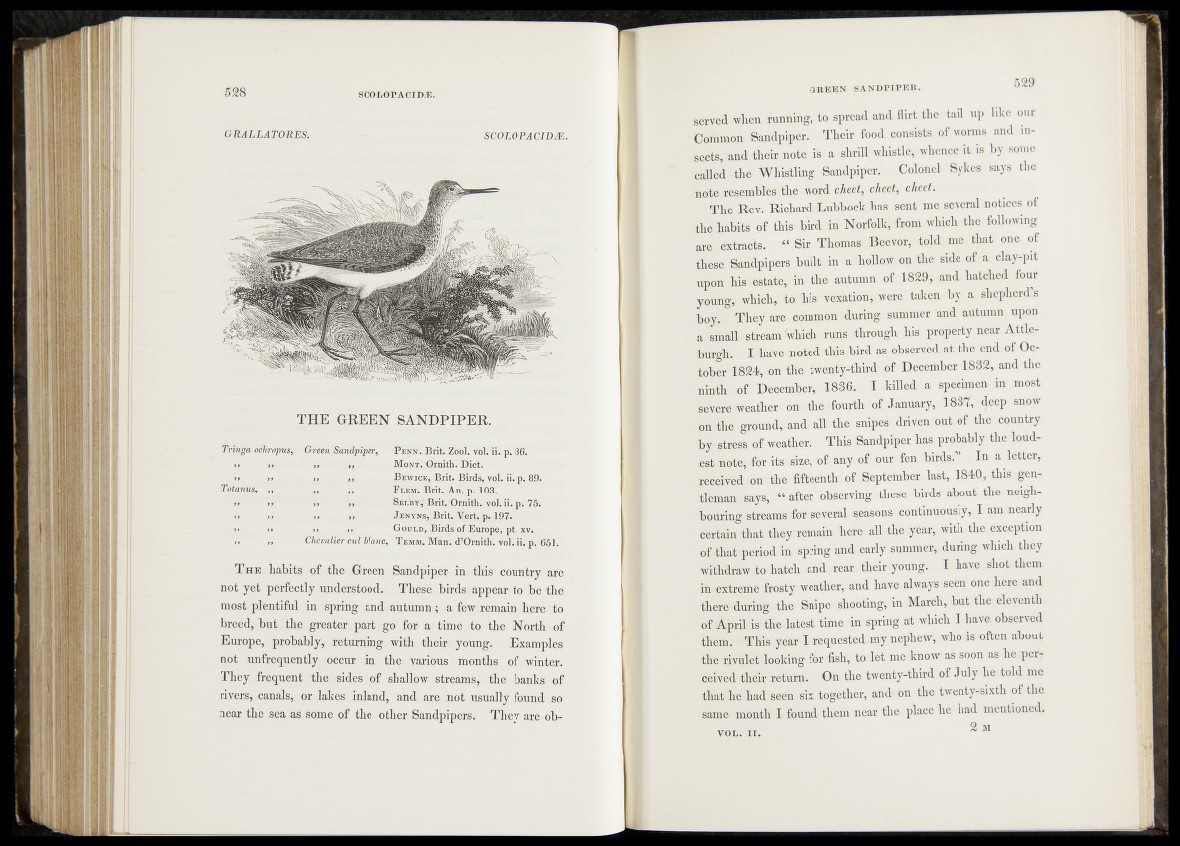
528 SCOLOPACIDÆ.
G R A L L A T O R E S . S C O L O P A C IDÆ .
T H E G R E EN SA N D P IP E R .
Tringa ochropus,
Tot anus,
Green, Sandpiper, P ens . 86. *1 '
\>?i MoNT. Ornith; Diet/
,, Bewice,-Brit. Birds,tYfijjSîu;R. 89,
,, ,, FLEM.'Priti’An. p. *"
V» » , Sei.^-j Brit. Ornith.' vol. iiî-‘pi 75.
Bnt. Vert. p. 197.
y > ■ *JT '.„y./’G ouiiP, JBirds of Europe, pt. ~xv.
-Chevalier cul blanc? Temm. Mân. d’Ornith'. vol.'ii. p. 651.
T he habits of the Green Sandpiper in this country are
not.,yet perfectly understood. These birds-appear to be the
most plentiful in spring and autumn; a few remain here to
breed, but the greater part , go for a time to the North of
Europe, probably,- returning with their young, , Examples
not unfrequently occur in the various months of winter.
They frequent the sides ,pf shallow streams, the banks of
rivers, canals, or lakes inland, and are riot usually found so
near the sea as some of the other Sandpipers. They are obgbeen
sa n d p ip e b .
served when funning, to spread and flirt the tail up like our
Common Sandpiper., Their food consists of worms and insects,
and their note- is a shrill whistle, whence it is by some
called the . Whistling Sandpiper. Colonel 'Sykes says the
note resembles, the word cheet, cheet, cheet.
The Rev. Richard Lubbock has sent ine several notices of
tlie habits of .this bird in Norfolk, from which the following
are extracts, K l Sir Thomas Beevor, told me that one of
these Sandpipers built in a hollow on the side of a clay-pit
upon his .estate,- in the autumn of: 1829, and hatched four
young? which,' ’tó^his vexation, were. taken ■ by a shepherd^
They are common -during summer and autumn upon
a small stream which runs through his property near Attle-
burgh. I have hotëd^this. bird as observed at the end of Oc-
tdbe'M^ffe bn the twenty-third of December 1832» and the
ninth of December, 18S6. I killed a specimen in most
severe weather- on jg s fo u rth '<* January, 1 « 4fep snow
ou tlie ground^ and all thhffmpes dtéyéh out of the country
H M of weather. This Sandpiper^has probably the loud,
-est hotf^förïf^sïaéj of any o f our fen birds.11 ; In a letter*
received mfeithe fifteenth' of .September last, 1840, this-gen,
tleman Isays, after j^ J ^ n ^ th e s ^ .b ir d s about the neigh*
bouring streams'for several seasons continuously, lam nearly
certain that they'remain"hefe.all-thVyear, with, the exception
of that period inv^pringland e a # summer* during which they
withdraw to hatch and rear^thei^ydungw I have shot them
inextremë frosty weather, and have.always seen one here and
there during |#ier Snip^shooting, in March, but the eleventh
of April i&tlfesdatest timeMn spring at which I have observed
threm. ■ This^êarT r e q u e s te d ^ nephew, who is often about
the!ri-vnlet doB-Mng for fish, to lét nie know as soon as he pert
heir return. On tfetwehty-third of JulyAé told me
th a th e had^Seen-.six-together, and..on the twenty-sixth of the
samè^febntfedfóhnd them near-the p la c e te had mentioned
2 M VOL. I I .